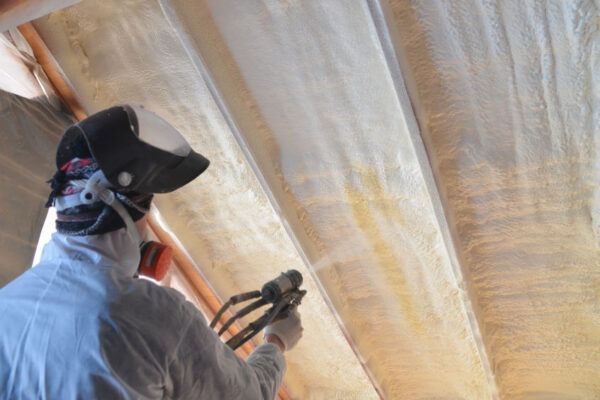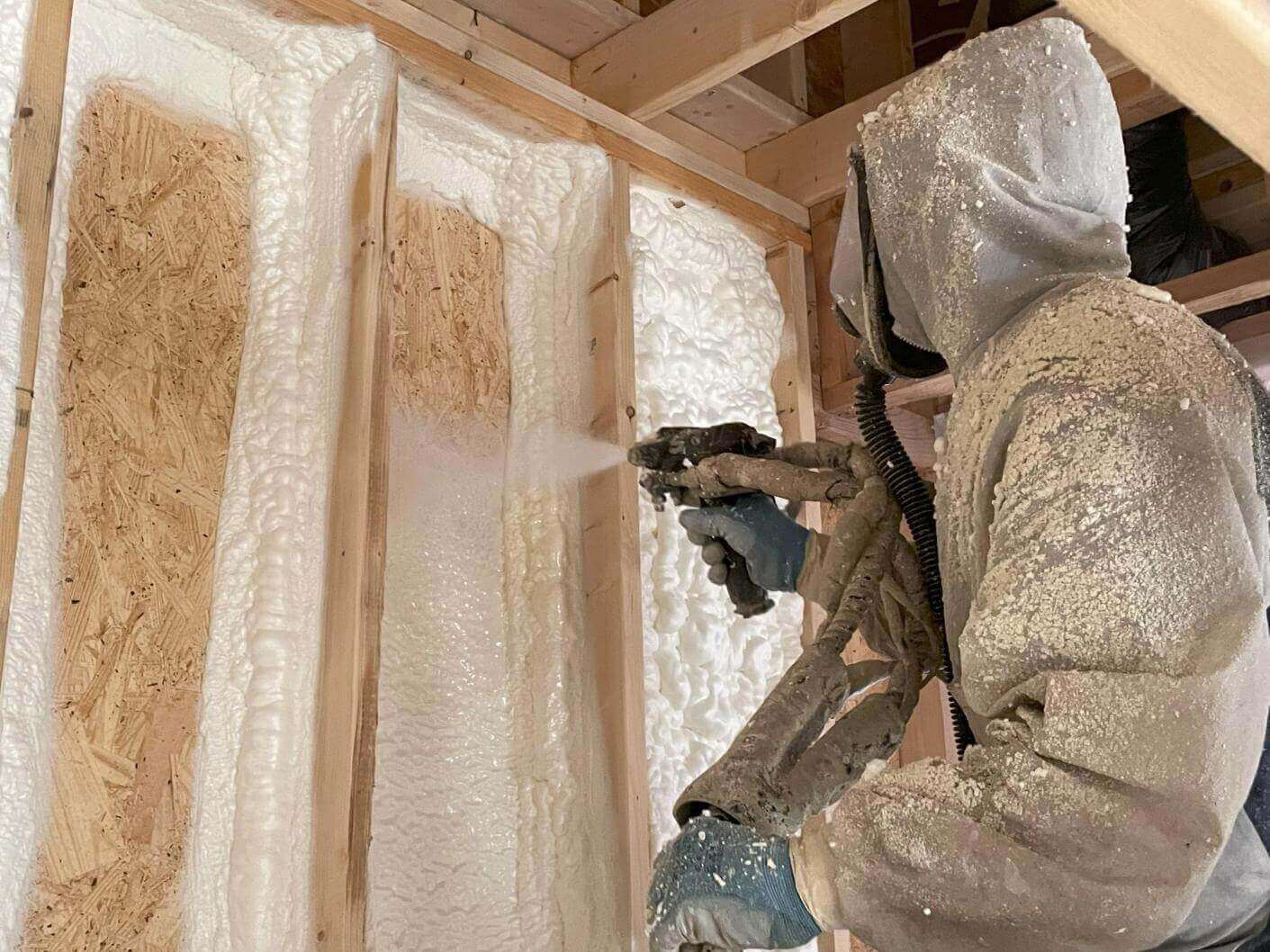The Ecological Impact of Spray Foam: Sustainability Factors To Consider
The Ecological Impact of Spray Foam: Sustainability Factors To Consider
Blog Article
Spray Foam: The Ultimate Option for Air Sealing and Insulation
Spray foam insulation has become a leading remedy for effective air sealing and thermal insulation, supplying a distinct mix of homes that establish it in addition to conventional approaches. Its ability to broaden and fill up voids makes it particularly efficient in stopping air leakage, which can significantly affect energy effectiveness. Understanding the full scope of its benefits, installation processes, and comparisons with other insulation types is essential for making notified decisions. As we check out these elements, the ramifications for both new buildings and retrofits become increasingly significant. What elements should influence your choice?
What Is Spray Foam?
Spray foam is a flexible insulation material that combines the concepts of air securing and thermal resistance to enhance power effectiveness in buildings. Made up largely of polyurethane or other similar substances, spray foam is applied as a liquid that increases upon contact with surfaces, producing a solid, continuous layer of insulation. This special building enables it to fill voids, fractures, and voids that typical insulation materials may forget, offering an exceptional air seal.
There are 2 primary types of spray foam: open-cell and closed-cell. Open-cell spray foam is lighter and extra versatile, supplying exceptional sound absorption and a reduced R-value per inch - Spray Foam. In contrast, closed-cell spray foam is denser, giving a greater R-value, moisture resistance, and included structural integrity to constructing elements
The application process typically entails customized devices, guaranteeing a smooth application that follows various substratums, including concrete, timber, and metal. This adaptability makes spray foam appropriate for both brand-new constructions and retrofitting existing frameworks. Its ability to produce an impermeable barrier substantially adds to decreasing power intake and improving interior air top quality, thereby making it a favored selection among home owners and contractors alike.
Benefits of Spray Foam Insulation
Among one of the most significant advantages of spray foam insulation is its outstanding ability to create a constant air obstacle, which properly minimizes energy loss. Unlike conventional insulation products, spray foam increases to load cracks and gaps, guaranteeing that air leak is substantially lowered. This particular not just enhances energy performance however additionally leads to decrease utility costs in time.
Additionally, spray foam insulation gives remarkable thermal resistance, adding to a much more secure interior environment. Its high R-value per inch enables reliable insulation in constrained rooms, making it optimal for attics, wall surfaces, and crawl rooms. The moisture-resistant residential properties of spray foam assistance prevent mold and mildew and mildew growth, advertising healthier living conditions.
An additional important benefit of spray foam insulation is its sound-dampening qualities (Spray Foam). It properly decreases noise transmission in between rooms, developing a quieter and much more comfy home atmosphere. The sturdiness of spray foam also sticks out, as it does not sag or resolve in time, keeping its performance throughout its life-span
Exactly How Spray Foam Functions
Recognizing how spray foam insulation functions is vital for valuing its efficiency in air securing and thermal resistance. Spray foam insulation includes 2 primary elements: isocyanate and polyol resin. When these elements are combined, they undergo a chemical response that causes the product to increase rapidly, developing a thick foam that fills up cavities, spaces, and splits.
As the foam increases, it abides by surfaces, developing an impermeable seal that considerably lowers air infiltration. This characteristic makes spray foam insulation extremely reliable at avoiding drafts and wetness infiltration, which can bring about energy loss and damage in time. Furthermore, the closed-cell variant of spray foam provides premium thermal resistance as a result of its inflexible framework, successfully decreasing heat transfer.
The special residential or commercial properties of spray foam permit it to comply with uneven surface areas, making certain comprehensive coverage and a seamless barrier. As a result, spray foam insulation not just boosts power performance yet additionally adds to boosted interior air high quality by minimizing the build-up of allergens and pollutants. Inevitably, recognizing the technicians behind spray foam highlights its function as an exceptional choice for insulation and air sealing in both industrial and domestic applications.
Installment Refine Summary

Prior to installation, the area has to be sufficiently cleansed and prepped, ensuring that surfaces are cost-free from dust, debris, and dampness. Since pollutants can endanger adhesion and overall performance, this action is critical. Once the area is prepared, the application includes blending the 2 components of the spray foam, which broadens upon get in touch with and loads gaps efficiently.
Educated specialists need to conduct the setup, making use of customized tools to guarantee consistent protection and ideal thickness. Security safety measures, consisting of using protective gear and guaranteeing proper ventilation, are necessary throughout this procedure. After application, the foam commonly treatments promptly, creating a strong obstacle that improves energy effectiveness.
Comparing Spray Foam to Traditional Insulation
When evaluating insulation alternatives, spray foam insulation attracts attention in contrast to standard materials such as fiberglass and cellulose. One of the key benefits of spray foam is its exceptional air sealing capabilities. Unlike fiberglass and cellulose, which can permit air infiltration, spray foam expands upon application, filling voids and gaps to develop a closed seal. This results in enhanced power effectiveness, as less warmed or cooled down air leaves the home, leading to reduced utility bills.
Furthermore, spray foam provides a higher R-value per inch than traditional insulation kinds, providing even more efficient thermal resistance in a thinner profile. This particular is especially Continue beneficial precede with restricted dental caries depth. Furthermore, spray foam is resistant to moisture and mold and mildew growth, which can be a considerable worry about cellulose and fiberglass, specifically in humid settings.
Nevertheless, spray foam insulation commonly brings a greater ahead of time cost than its standard equivalents. Homeowners should consider this initial investment versus lasting energy savings and performance advantages. Inevitably, while both insulation types serve their purpose, spray foam emerges as a much more innovative solution for modern insulation needs, especially in terms of air securing and thermal performance.

Conclusion
In summary, spray foam insulation represents a highly effective solution for achieving optimal air sealing and thermal resistance. Its distinct Get More Information residential properties, consisting of wetness resistance and noise dampening, make it appropriate for different applications in both new constructions and retrofitting projects (Spray Foam). Although the initial prices might be higher compared to traditional insulation products, the lasting advantages, such as considerable energy financial savings and boosted interior air quality, justify the financial investment and highlight its value in modern structure methods.
Spray foam insulation has arised as a leading solution for reliable air sealing and thermal insulation, offering a special combination of residential or commercial properties that set it apart from standard methods.Spray foam is a functional insulation material that combines the concepts of air sealing and thermal resistance to boost energy performance in buildings.When reviewing insulation choices, spray foam insulation stands out in contrast to standard products such as fiberglass and cellulose. Eventually, while both insulation kinds serve Full Article their objective, spray foam emerges as a much more advanced option for modern insulation requirements, specifically in terms of air securing and thermal efficiency.
In recap, spray foam insulation stands for a highly efficient solution for accomplishing optimum air sealing and thermal resistance.
Report this page